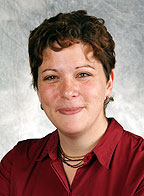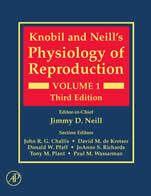Biomedical Sciences trio tapped to author leading text
 The world’s leading comprehensive textbook on the physiology of reproduction now includes chapters from three Cornell faculty members in the Department of Biomedical Sciences at the College of Veterinary Medicine.
The world’s leading comprehensive textbook on the physiology of reproduction now includes chapters from three Cornell faculty members in the Department of Biomedical Sciences at the College of Veterinary Medicine.
Authored and edited by scientists at the forefront of the field, Knobil and Neill's Physiology of Reproduction is a staple reference on faculty members’ and libraries’ shelves in veterinary schools, medical schools, and biomedical research hubs across the world.
Entering its fourth edition, the book covers basic biological principles at the organismic and molecular levels relevant to humans and other animals. As comprehensive literature reviews of their respective topics, typical chapters include between 35,000 and 40,000 words and 600-700 citations, taking months to complete.
“Our department is privileged to include so many people tapped to contribute to this important text,” said Dr. Mark Roberson, chair of the biomedical sciences department and one of the authors. “That our department is so well represented speaks to the broader role and recognition of top-tier reproductive biology research at Cornell.”
Roberson authored a new chapter with coauthor Dr. Craig McArdle, lecturer at University of Bristol, England. Called “Gonadotropes and gonadotropin releasing hormone signaling,” it discusses how the brain and pituitary gland controls fertility in mammals by integration of the biosynthesis and secretion of pituitary hormones that control ovarian and testicular function.
 Associate Professor of Genetics Dr. Paula Cohen and Research Scientist Dr. Kim Holloway co-authored a new chapter entitled “Mammalian meiosis and meiotic recombination” discussing how germ cells (sperm and eggs) form and converge to share genes to make new life.
Associate Professor of Genetics Dr. Paula Cohen and Research Scientist Dr. Kim Holloway co-authored a new chapter entitled “Mammalian meiosis and meiotic recombination” discussing how germ cells (sperm and eggs) form and converge to share genes to make new life.
“Understanding meiosis is not only essential for our understanding of chromosome biology and germ cell development, but also for our understanding of some of the principal human reproductive disorders,” said Cohen. “Around half of human eggs bear some sort of abnormality because of meiotic errors. These ‘bad eggs’ can result in miscarriage, failed implantation, or birth defects such as Down Syndrome or Klinefelter. Surprisingly, up until this issue of the book, there had never been a meiosis chapter included.”
 Professor of Biomedical Science Dr. Susan Suarez updated a chapter from the previous edition of which she was the sole author. Entitled “Gametes and zygote transport,” the chapter incorporates her expertise in sperm behavior and the relationship between gametes and the reproductive tract.
Professor of Biomedical Science Dr. Susan Suarez updated a chapter from the previous edition of which she was the sole author. Entitled “Gametes and zygote transport,” the chapter incorporates her expertise in sperm behavior and the relationship between gametes and the reproductive tract.
“It was really a pleasure to be able to review the literature in our field in such a comprehensive way,” said Roberson. “You have to dig in pretty deep to understand the full breadth of a subject. I think we learned more by writing our chapters than we would have from just reading them.”





